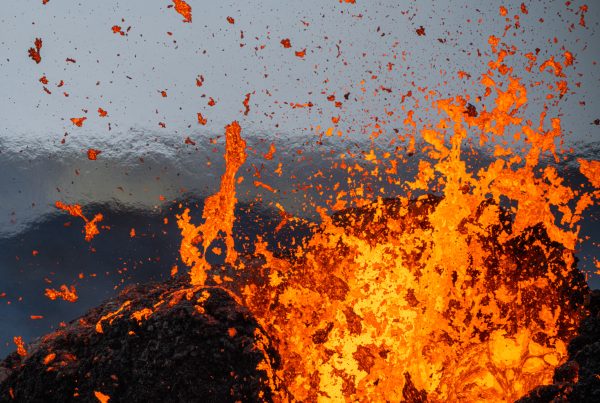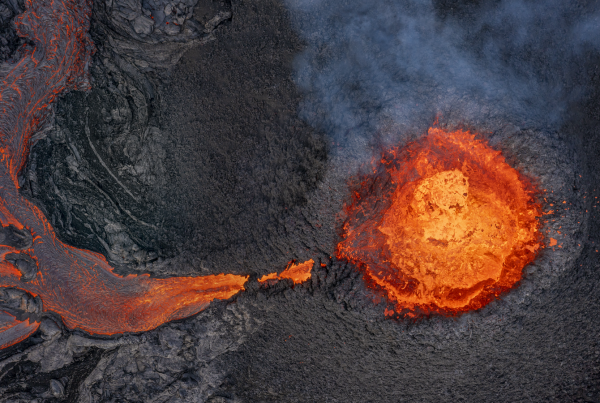Insights from Experts and Safety Tips

The March eruption in the vicinity of Grindavík, blocked by defensive walls.
Iceland’s recent volcanic activity has garnered significant attention, prompting a need for clear and factual information for those planning to visit. This article provides an updated analysis of the March 2024 eruption, incorporating new insights from geological experts, the educational contributions of the LAVA Centre, and detailed safety guidelines for travellers.
Current Status of the Eruption: A Singular Active Crater
As of the latest updates, the volcanic activity in Iceland has notably subsided, with only one crater remaining active. This current phase of the eruption is characterised by a lower intensity, suggesting that the power of the eruption has diminished significantly.
Diminished Volcanic Power and Lowered Hazard Levels
The Icelandic Meteorological Office has reported that the strength of the eruption has decreased, leading to a reduction in the hazard level for surrounding areas. This change reflects the ongoing monitoring and analysis conducted by geological experts, who continue to observe the eruption’s progression closely.
Reopening of the Blue Lagoon

Watching towards Sundhnúkagýgar from the Blue Lagoon. Photo by Leo_Visions on Unsplash
In light of the reduced hazard levels, the iconic Blue Lagoon is set to reopen today (6 April). The decision comes after a comprehensive risk assessment concluded that the area is now safe for visitors. This reopening is a positive sign for Iceland’s tourism industry and offers reassurance to potential guests that the country is adept at managing volcanic events while minimising disruption to its attractions.
The current situation represents a stable period in the volcanic activity, allowing authorities to adjust safety measures accordingly and providing an opportunity for visitors to safely experience the unique geothermal wonders of Iceland.
In-Depth Analysis of Magma Origins
Geologists have determined that the magma responsible for the March 2024 eruption originates from a depth of approximately 15 km (9.3 miles). Benedikt Gunnar Ófeigsson, a geologist, emphasises the scientific importance of this discovery: “The depth at which this magma comes from is unusual and offers valuable data for understanding the composition of the mantle and the inner workings of tectonic activities.” (Iceland Monitor)
This deep-origin magma provides researchers with critical information about the Earth’s interior processes, which can lead to more accurate predictions and understanding of volcanic behaviour.
The Educational Role of the LAVA Centre
The LAVA Centre in Iceland plays a pivotal role in disseminating knowledge about the country’s geology. It offers visitors current and precise information about volcanic and seismic activities. A representative from the centre states, “We provide comprehensive educational material that helps visitors comprehend the complexities of Iceland’s geology.”
Interactive exhibits at the LAVA Centre allow individuals to learn about the mechanisms of eruptions and earthquakes in a controlled setting, emphasising the importance of education in understanding natural phenomena.
Comprehensive Safety Information for Visitors
The safety of tourists and residents is a top priority in Iceland, especially during periods of increased volcanic activity. The Icelandic Meteorological Office (IMO) closely monitors such events and collaborates with other agencies to provide timely travel advisories and air quality updates. Resources like Visit Iceland are invaluable for obtaining the most current safety information.
An IMO representative assures, “Our sophisticated monitoring and emergency response systems are specifically designed to protect everyone on the island.” These measures have enabled areas like the Blue Lagoon to resume operations after careful risk assessments confirmed their safety.
Statements from Authorities on Visitor Safety
Local authorities and the tourism board have issued statements confirming that Iceland remains a safe destination for travellers. They highlight the country’s effective safety protocols and infrastructure that ensure visitor security. “The well-being of our visitors is a primary concern,” a tourism board spokesperson remarks. “We are committed to maintaining and communicating the safety standards that allow tourists to explore Iceland confidently.”
Recent observations indicate a decrease in volcanic activity, with only one crater remaining active. This suggests that the eruption could be approaching its conclusion, allowing normal tourism activities to proceed with minimal impact.
With expert insights from IMO, specialists like Ófeigsson and resources like the LAVA Centre, visitors can enhance their understanding of these natural events. Backed by thorough safety protocols, Iceland invites travellers to experience its unique geological landscape with assurance of their safety.



